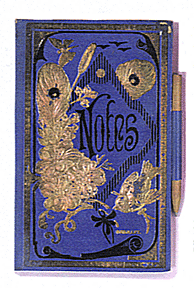 Today, we have smart phones and tablets to help organize our lives. In Victorian
times, people used elastic slate books, a series of two or more slates
hinged together, folded up like a book. The New York Silicate Book Slate
Company first produced these in 1867.
Today, we have smart phones and tablets to help organize our lives. In Victorian
times, people used elastic slate books, a series of two or more slates
hinged together, folded up like a book. The New York Silicate Book Slate
Company first produced these in 1867.
Dr. Daniel R. Schaefer's Cyclopedia of Things Worth Knowing,
published in 1874, states, "Elastic slates have come to be almost a
necessity, on account of being light, and easily carried in the pocket
as a memorandum book... notes and writing can be easily effaced, leaving
the service clean and ready for further use."
Artificial book slates, made of fine sand, lamp black, and boiled
linseed oil, were painted with a mixture of turpentine and black oil
paint. After several thin coats, workers rubbed them smooth with a piece of
turpentine-saturated cotton cloth. The person using one drew on them
with a special slate pencil.
